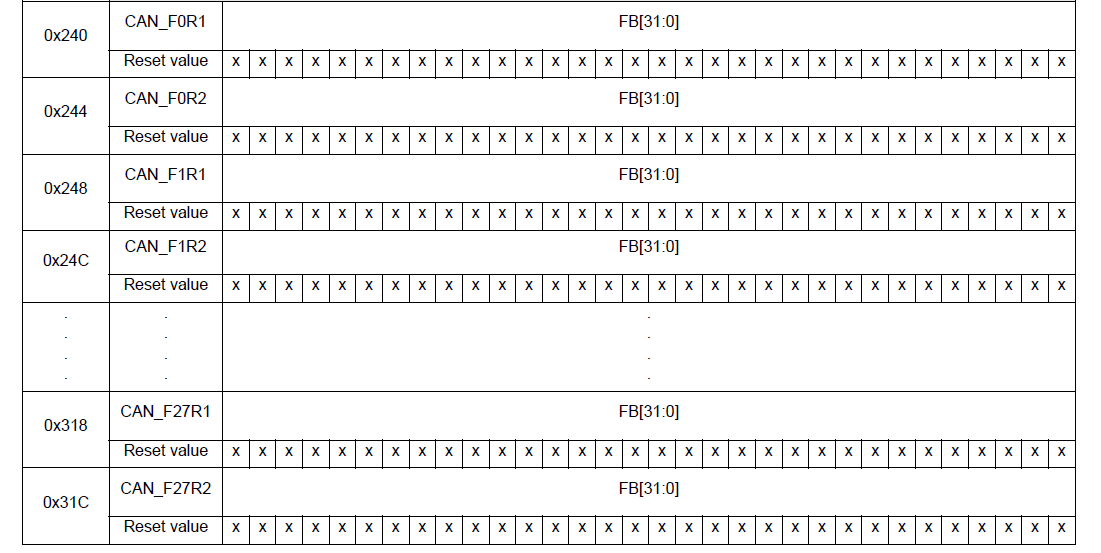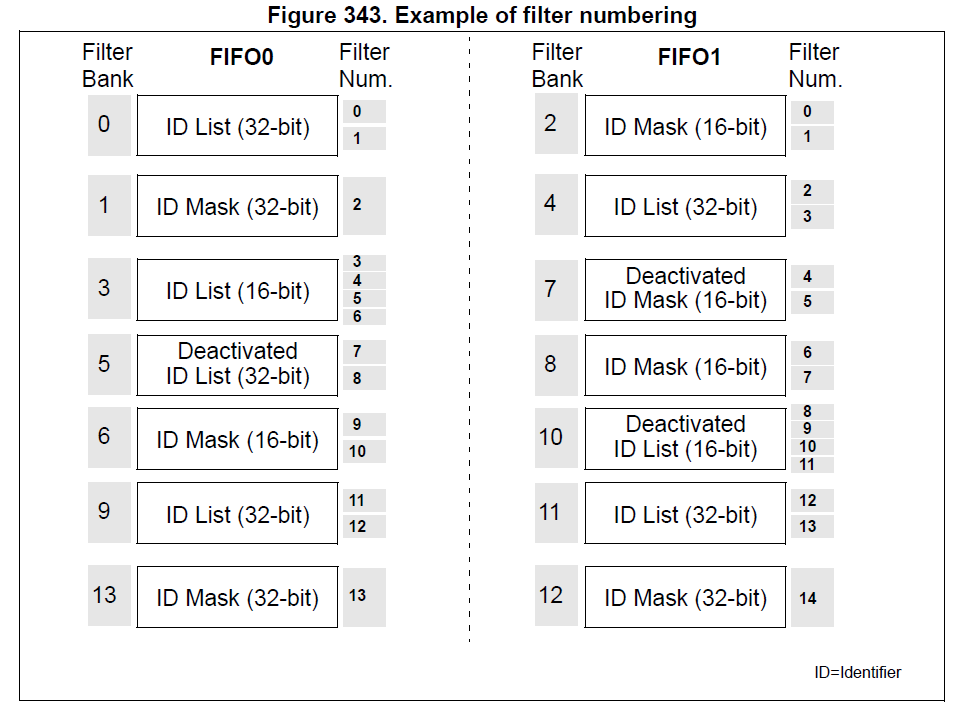STM32 Controller area network (bxCAN) Identifier filtering
Identifier filtering
In the CAN protocol the identifier of a message is not associated with the address of a node but related to the content of the message.
Consequently a transmitter broadcasts its message to all receivers.
On message reception a receiver node decides - depending on the identifier value - whether the software needs the message or not.
If the message is needed, it is copied into the SRAM.
If not, the message must be discarded without intervention by the software.
To fulfill this requirement, the bxCAN Controller provides 28 configurable and scalable filter banks (27-0) to the application.
In other devices the bxCAN Controller provides 14 configurable and scalable filter banks (13-0) to the application
in order to receive only the messages the software needs.
This hardware filtering saves CPU resources which would be otherwise needed to perform filtering by software.
Each filter bank x consists of two 32-bit registers, CAN_FxR0 and CAN_FxR1. = 2 * 28 = 56 Registers


Scalable width
To optimize and adapt the filters to the application needs, each filter bank can be scaled independently.
Depending on the filter scale a filter bank provides:
One 32-bit filter for the STDID[10:0], EXTID[17:0], IDE and RTR bits.
Two 16-bit filters for the STDID[10:0], RTR, IDE and EXTID[17:15] bits.
Furthermore, the filters can be configured in mask mode or in identifier list mode.
Mask mode
In mask mode the identifier registers are associated with mask registers specifying
which bits of the identifier are handled as must match or as dont care.
Each bit of the register specifies whether the bit of the associated identifier register
must match with the corresponding bit of the expected identifier or not.
0: Dont care, the bit is not used for the comparison --- Don't Care
1: Must match, the bit of the incoming identifier must have the same level
has specified in the corresponding identifier register of the filter -- Do Care.
Identifier list mode
In identifier list mode, the mask registers are used as identifier registers.
Thus instead of defining an identifier and a mask, two identifiers are specified,
doubling the number of single identifiers.
All bits of the incoming identifier must match the bits specified in the filter registers.
Each bit of the register specifies the level of the corresponding bit of the expected identifier.
0: Dominant bit is expected
1: Recessive bit is expected
Filter bank scale and mode configuration
The filter banks are configured by means of the corresponding CAN_FMR register.
To configure a filter bank it must be deactivated by clearing the FACT bit in the CAN_FAR register.
The filter scale is configured by means of the corresponding FSCx bit in the CAN_FS1R register, refer to Figure 342.
The identifier list or identifier mask mode for the corresponding Mask/Identifier registers is configured
by means of the FBMx bits in the CAN_FMR register.
To filter a group of identifiers, configure the Mask/Identifier registers in mask mode.
To select single identifiers, configure the Mask/Identifier registers in identifier list mode.
Filters not used by the application should be left deactivated.
Each filter within a filter bank is numbered (called the Filter Number)
from 0 to a maximum dependent on the mode and the scale of each of the filter banks.
Concerning the filter configuration, refer to Figure 342.
Filter match index
Once a message has been received in the FIFO it is available to the application.
Typically, application data is copied into SRAM locations.
To copy the data to the right location the application has to identify the data by means of the identifier.
To avoid this, and to ease the access to the SRAM locations, the CAN controller provides a Filter Match Index.
This index is stored in the mailbox together with the message according to the filter priority rules.
Thus each received message has its associated filter match index.
The Filter Match index can be used in two ways:
Compare the Filter Match index with a list of expected values.
Use the Filter Match Index as an index on an array to access the data destination location.
For nonmasked filters, the software no longer has to compare the identifier.
If the filter is masked the software reduces the comparison to the masked bits only.
The index value of the filter number does not take into account the activation state of the
filter banks. In addition, two independent numbering schemes are used, one for each FIFO.
Refer to Figure 343 for an example.

Filter priority rules
Depending on the filter combination it may occur that an identifier passes successfully through several filters.
In this case the filter match value stored in the receive mailbox is chosen according to the following priority rules:
A 32-bit filter takes priority over a 16-bit filter.
For filters of equal scale, priority is given to the Identifier List mode over the Identifier Mask mode
For filters of equal scale and mode, priority is given by the filter number (the lower the number, the higher the priority).

The example above shows the filtering principle of the bxCAN. On reception of a message, the identifier is compared first with the filters configured in identifier list mode.
If there is a match, the message is stored in the associated FIFO and the index of the matching filter is stored in the Filter Match Index.
As shown in the example, the identifier matches with Identifier #2 thus the message content and FMI 2 is stored in the FIFO.
If there is no match, the incoming identifier is then compared with the filters configured in mask mode.
If the identifier does not match any of the identifiers configured in the filters, the message is discarded by hardware without disturbing the software.
STM32 Controller area network (bxCAN) Identifier filtering的更多相关文章
- 再谈STM32的CAN过滤器-bxCAN的过滤器的4种工作模式以及使用方法总结
1. 前言 bxCAN是STM32系列最稳定的IP核之一,无论有哪个新型号出来,这个IP核基本未变,可见这个IP核的设计是相当成熟的.本文所讲述的内容属于这个IP核的一部分,掌握了本文所讲内容,就可以 ...
- Real-time storage area network
A cluster of computing systems is provided with guaranteed real-time access to data storage in a sto ...
- 存储区域网络(Storage Area Network,简称SAN)
存储区域网络(Storage Area Network,简称SAN)采用网状通道(Fibre Channel ,简称FC,区别与Fiber Channel光纤通道)技术,通过FC交换机连接存储阵列和服 ...
- mvc action controller area
获取控制器名称: ViewContext.RouteData.Values["controller"].ToString(); 获取Action名称: ViewContext.Ro ...
- linux 下使用 tc 模拟网络延迟和丢包-使用 linux 模拟广域网延迟 - Emulating wide area network delays with Linux
tc 是linux 内置的命令:使用man pages 查看 我们看到,其功能为 show / manipulate traffic control settings,可对操作系统进行流量控制: ne ...
- HDU 2125 Local area network
简单DP,N×M的网格其中有一条边坏掉了,问从起点到终点的放法数 有两种方法,一种是DP很好理解 //#define LOCAL #include <cstdio> #include &l ...
- STM32(12)——CAN
简介: CAN是Controller Area Network,是 ISO 国际标准化的串行通信协议. CAN 控制器根据两根线上的电位差来判断总线电平.总线电平分为显性电平和隐性电平,二者必居其一 ...
- stm32之CAN总线基础
can总线协议概述: CAN是Controller Area Network的缩写,由德国博世公司开发:CAN通过ISO11891以及ISO11519进行了标准化: CAN总线的特点: 1.多 ...
- CAN通信(STM32)
1.CAN是控制器局域网络(Controller Area Network, CAN)的简称 (理论知识不做讲解了,太多了) 2.芯片选用:TJA1050 差分信号输入, 这里的显性电平CANH和CA ...
随机推荐
- vue双向绑定原理分析
当我们学习angular或者vue的时候,其双向绑定为我们开发带来了诸多便捷,今天我们就来分析一下vue双向绑定的原理. 简易vue源码地址:https://github.com/jiangzhenf ...
- mybatis开发dao的方法——(三)
------------------------1. SqlSession使用范围------------------- 1.1 SqlSessionFactoryBuilder 通过S ...
- Linux内核源码分析--内核启动之(1)zImage自解压过程(Linux-3.0 ARMv7) 【转】
转自:http://blog.chinaunix.net/uid-25909619-id-4938388.html 研究内核源码和内核运行原理的时候,很总要的一点是要了解内核的初始情况,也就是要了解内 ...
- mac lsof使用查看端口
安装 brew install lsof 在Mac OS系统中,无法使用netstat来查看端口占用情况,可以使用lsof来代替,这种方式在Linux下也适用. sudo lsof -nP -iTCP ...
- 用Python连接SQLServer抓取分析数据、监控 (pymssql)
Python 环境:python3 服务器环境: centos6.5 数据库: Mysql 大概流程:在装有Python服务器,利用pymssql库连接MSSQL生产数据库取出数据然后写进mysql数 ...
- 数组slice方法
slice slice(start,end):方法可从已有数组中返回选定的元素,返回一个新数组,包含从start到end(不包含该元素)的数组元素.(不会改变原数组) start参数:必须,规定从何处 ...
- Android 7.0 新增功能和api
Android 7.0 Nougat 为用户和开发者引入多种新功能.本文重点介绍面向开发者的新功能. 请务必查阅 Android 7.0 行为变更以了解平台变更可能影响您的应用的领域. 要详细了解 A ...
- 虚拟机Failed to start LSB: Bring up/down networking
1.执行 service network restart 出现以下错误 Restarting network (via systemctl): Job for network.service f ...
- hdu 1272 判断所给的图是不是生成树 (并查集)
判断所给的图是不是生成树,如果有环就不是,如果没环但连通分量大于1也不是 find函数 用递归写的话 会无限栈溢出 Orz要加上那一串 手动扩栈 Sample Input6 8 5 3 5 2 6 4 ...
- Mvc+Dapper+存储过程分页10万条数据
10万条数据采用存储过程分页实现(Mvc+Dapper+存储过程) 有时候大数据量进行查询操作的时候,查询速度很大强度上可以影响用户体验,因此自己简单写了一个demo,简单总结记录一下: 技术:Mvc ...
